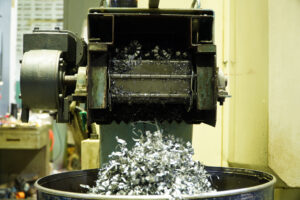
The need for an eco-friendly approach to metal manufacturing is the biggest challenge facing the industry. As the effects of climate change become more apparent, metal manufacturers are turning to innovative solutions to reduce their carbon footprint.
This is an industry-wide change that is gathering pace for decision-makers. Partially fueled by plans like the Fabricators & Manufacturers Association’s Green Manufacturer Network, this change is essential, not just for the environment but to remain competitive in a market where “green credentials” are increasingly valued.
From energy-efficient machinery to sophisticated software and advanced recycling techniques, here are some of the most promising eco-friendly innovations in metal manufacturing.
The role of energy efficiency
Reducing the energy required to manufacture metal is one of the most achievable ways to reduce carbon emissions. From a business perspective, energy efficiency also makes complete sense. According to World Steel, energy usage in metal manufacturing accounts for 20 to 40 per cent of manufacturing costs. Recent innovations are helping manufacturers cut this percentage. This not only reduces their carbon footprint but also lowers operational costs.
Among key innovations to achieve this are:
- Electric arc furnaces: These furnaces consume far less energy than traditional blast furnaces, making them an increasingly popular choice for manufacturers looking to reduce emissions.
- Renewable energy sources: Many metal manufacturing plants are now powered by renewable energy such as wind, solar, and hydropower, further decreasing reliance on fossil fuels.
- Heat recovery systems: Advanced systems capture waste heat from industrial processes and reuse it, which lowers energy consumption and enhances overall efficiency.
Energy reduction is not a new trend. World Steel reports the cost of producing a tonne of crude steel has dropped by 60 per cent since 1960. However, with today’s innovations, the pace of change is accelerating across the industry.
Recycling and material efficiency
This area also makes complete sense both from a business and an environmental perspective. The process of recycling metals uses significantly less energy than producing new metals from raw materials, making it an efficient and sustainable approach. As the demand for sustainability grows, innovations in recycling technology are helping manufacturers optimize material usage and minimize waste.
Among the technologies helping to achieve this are:
- Scrap metal processing: Advanced technologies now enable better sorting, cleaning, and processing of scrap metal, allowing manufacturers to reuse higher-quality materials and reduce their reliance on newly mined resources.
- Precision manufacturing: Innovations like 3D printing and computer-aided design (CAD) are helping manufacturers minimize material waste by allowing for more accurate production and reducing excess.
- Closed-loop systems: These systems ensure waste materials generated during the manufacturing process are captured, recycled, and reintroduced into production, reducing the need for new materials.
Moving to a more circular economy is critical. By focusing on improved recycling and material efficiency, manufacturers can help the shift towards a more sustainable and cost-effective future.
Technology and process improvements
The rapid rise of technologies such as the Industrial Internet of Things (IIoT), AI, cloud computing, and sophisticated software have transformed manufacturing.
For manufacturers, these technologies represent the dawn of a new age. From streamlining processes to increased automation, such improvements cut energy consumption while boosting productivity–conditions manufacturers seek.
Among the technologies powering this transformation are:
- OEE software: Overall equipment effectiveness (OEE) software plays a crucial role in optimizing production. By monitoring machine performance in real-time, OEE helps manufacturers identify inefficiencies, reduce downtime, and improve throughput. This leads to shorter cycle times and lower energy usage, making the manufacturing process more eco-friendly.
- Automation and AI: Advanced technologies like automation and artificial intelligence (AI) are also helping to reduce the manufacturing cycle time. These tools allow for real-time adjustments to production, ensuring resources are used efficiently and energy consumption is minimized.
- Predictive maintenance: By utilizing sensors and data analytics, predictive maintenance ensures equipment runs optimally. This prevents breakdowns, reduces waste, and extends the lifespan of machinery, further cutting emissions.
With the integration of tools like OEE software and AI, manufacturers can optimize manufacturing cycle time and drive down carbon emissions, contributing to a more sustainable production process.
Other key innovations
While these innovations are the backbone of the switch to more sustainable metal manufacturing, they are by no means the only ones. Other key innovations include:
- Low-carbon alloys: Manufacturers are developing and adopting low-carbon alloys requiring less energy to produce while maintaining performance standards, helping to reduce overall emissions.
- Sustainable raw material sourcing: More companies are turning to responsibly sourced and certified raw materials, ensuring metal extraction is done with minimal environmental harm and robust traceability throughout the supply chain.
- Water conservation technologies: Metal manufacturing often requires significant water usage. Innovations in water recycling and treatment are allowing manufacturers to reduce water consumption and limit wastewater discharge, further improving sustainability.
Sustainability in manufacturing is all about pushing the boundaries of possibility. The sustainability bar is continually being raised, and manufacturers must keep raising their game to match.
Building a low-carbon future in metal manufacturing
According to the National Center for Biotechnology Information, the production of metals accounts for 40 percent of all industrial greenhouse gas emissions and 10 per cent of global energy consumption. These statistics underline the importance of a more sustainable approach to metal manufacturing. For the industry not just to survive–but to prosper–it needs to acknowledge this fact and address it. By turning to more energy-efficient practices, optimizing manufacturing cycle times, and employing innovative technologies, the sector can play a major role in reducing global emissions and contributing to a greener future for generations to come.





